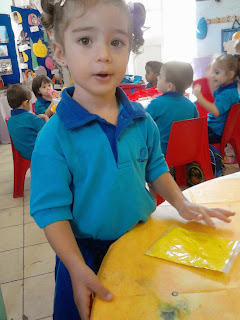Paint Bag Writing
Learning to write letters and numbers can be frustrating for little hands! I like to offer lots of play activities that help build those fine motor skills in a relaxed, fun way. Toddlers and up will enjoy making shapes, swirls, and even letters on a plastic bag filled with paint.
To make your own paint bag writing tablet, put some finger paint or tempera paint into a sturdy freezer zip-top plastic bag. Seal it well and smoosh the paint around the entire bag. (You could even add a strip of packing tape across the top if you are worried about your child opening the bag.) That’s it!
We like to tape ours down to the table so it doesn’t wiggle around too much. Try doodling and writing with your finger first. Your child may also enjoy using a cotton swab to write with. When your tablet is full of scribbles (or sight words for older kids), smoosh and smear the paint around and start over. No mess, just fun!
Happy playing!














































